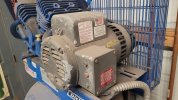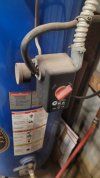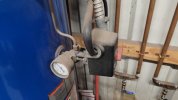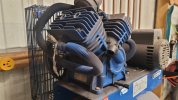In examining pictures on this thread--it surprised me to see a pressure relief valve (PRV) mounted by the maker of the finished air compressor in the horizontal position coming off the top head of the tank. PRV's with spindles vertical are the best method for safety and reliability and the standard in the boiler and pressure vessel industry. I've seen several instances of freeze-up on PRV's mounted horizontally outside on air compressor tanks and an instance of foreign materials getting lodged in the relief discharge ports preventing it from operating in a manufacturing plant. I checked ASME Section VIII, Div. 1-2021 (the build code for the tank) this morning and there is no prohibition on this for compressed air service only a warning. And it is there for a reason--someone had a problem. Something to consider.
Most of the time today--the maker of the air receiver tank is not the maker of the assembled compressor unit. Ingersoll Rand (IR) used to use Morganton Tanks and many other air compressor makers bought from one plants of Manchester Tanks. There are several other good domestic tank manufacturers and some in Canada and Mexico that I have used and seen. ASME certification is a level playing field worldwide for accredited manufacturers. They are all good commodity tanks typically 24"OD and rated for 200psi -20F to 650F and optimized to use the least amount of material to contain 80 gallons of air. That's about 10 Cubic feet conveniently. Unfortunately--they are thin from the get go when new with 3/16" thick shell plates and the same or slightly thinner on the heads with respect to heat transfer. New and cold the safety factor is 350% on design stresses. These tanks have tremendous safety factor--provided they don't corrode away in service. These tanks at the completion of being made undergo hydrotest of 1.3 times whatever the pressure rating of the tank is. The IR I use has no metal corrosion allowance provided for in its design of the tank. When I ultrasonically thickness tested it recently I was surprised that it had lost about a 1/16" on the bottom head in ten years of service and it has a timed dump on it for every hour. If people forget about draining every day--then It does not take too long to have a corrosion issue taking the head or shell thickness below its minimum wall condition and rendering the tank junk essentially. When I looked at a 50 hp Quincy rotary screw running last week--it was pulling 60F air in the compressor shed and was outputting a bit over 200 cfm of compressed air at 146-149F. The large after cooler took it to 69F. The pressure output was 130 psi. The 400 gallon tank it feeds was draining every ten minutes and a lot more water than I expected to see on a day with a 41F dewpoint. Another tank of 80 gallon capacity had to be plumbed in series to get the last of the moisture dropped out as far as it mattered to that user.
I encourage people who have commercial type air compressor tanks in their home garages to find the ASME Manufacturer's plate on it and order the "ASME Form U-1A Data Report" from the National Board of Boiler and Pressure Vessel Inspectors for their tank. that's the legal paper work for the tank. Most of the time in the remarks section of that report that business will state: "Anti-vibration system and safety valve not provided by them". It is usually $26 via their website. In US states with active boiler and pressure vessel programs-- 60 gallon and up air receiver tanks are inspected every five years typically internally and externally for businesses. For home shop things usually not--and then the onus for all liability falls on the owner in the event of a rupture. These pressure vessels are fair sized bombs that often results in a fire or deaths on rupture due to thinning. The weakest link is often the long seam weld on the shell for a vertical tank.
For the original poster on this thread--you may want to contact the boiler/pressure vessel section in Olympia, Washington and inquire about PEX pipe. Washington state has a good program that wants to help people avoid having problems. One of its liabilities is it is amorphous, not recognized by any industrial piping code for other than potable water service. It has little fracture toughness. PVC is the same way. Some places it is allowed for compressed air outside only and 24" burial depth in areas not frequented by the public.




